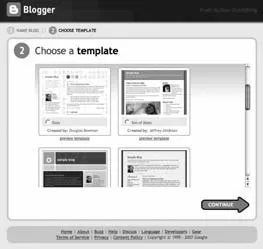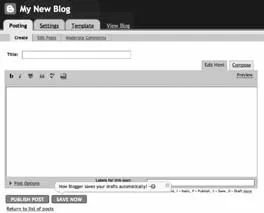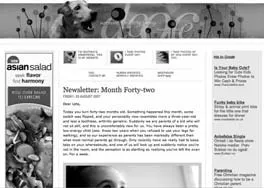![]()
CHAPTER ONE
What is a Blog?
To really understand blogs, you need to read them over time. Following a blog is like getting to know someone, or like watching a television series. Because blogging is a cumulative process, most posts presuppose some knowledge of the history of the blog, and they fit into a larger story. There’s a very different sense of rhythm and continuity when you follow a blog, or a group of blogs, over time, compared to simply reading a single post that you’ve found through a search engine or by following a link from another Web site.
In most forms of print publishing, such as newspaper articles, novels or poetry, the author is not in charge of the way the text will look. The text is written in a word processor (or on a typewriter, or by hand) and submitted to an editor who, usually with a sta¤ of designers, determines the layout. Bloggers, on the other hand, choose their own template and often spend considerable time adjusting the way their blogs look and work. A literary critic will rarely see the binding of a book as being important to its literary quality. A blog, however, cannot be read simply for its writing, but will always be seen as the sum of writing, layout, connections and links, and tempo.
The best way of figuring out what a blog is is simply to look at some examples. I’ve chosen three blogs for us to look at and analyse: a personal, diary-style blog, a political blog and a blog that combines expertise with a personal twist. After examining these blogs, I’ll discuss some definitions of blogs and consider how well they suit our examples. One of the most important reasons for the popularity of blogging is that it is extremely easy to do – so, first of all, let’s look at the mechanics of blogging and how you do it. If you’re already a blogger, you might want to skip ahead to the examples of different kinds of blog: personal blogs, filter blogs and topic-driven blogs.
How to Blog
There are many online services that will let you set up your own blog for free, and that will host your blog for you on their server. Blogger.com was the first major service to do this, and is still one of the most popular blogging sites, but there are many others, including Wordpress.com, Livejournal.com, TypePad.com, as well as many sites that are specific to a particular country or region.
All these sites require you to create a user account. You’re then asked to choose a name for your blog and a URL. Sites that o¤er free hosting for your blog will generally have a fixed domain for all hosted blogs but allow you to choose the first part of the URL. For instance, Blogger.com hosts users’ blogs at blogspot.com, so you could choose the URL http://newblog.blogspot.com or http://myfirstblog.blogspot.com, assuming these URLs aren’t already taken. If you already have your own domain (mydomain.com, for instance), you can set the blog up to publish to it instead. The next step is to select a template or theme for your blog (see figure 1). Most blogging services have many different templates to choose from. Later, if you like, you can edit your template to make it just the way you want it. Some of these edits are easy to do, but more complex editing requires basic knowledge of HTML and CSS. HTML stands for HyperText Markup Language, and is the code for writing a Web page that can be displayed in a Web browser. For instance, in HTML, you put the tag <p> at the beginning of a paragraph, and the tag </p> at the end of a paragraph. The browser then knows that text between those two tags should be displayed as a separate paragraph rather than just as a long string of text connected to the text that comes before and after. CSS stands for Cascading Style Sheets, and is a way of specifying how the Web browser should ‘style’ or present pages that are marked up in HTML. So, for instance, a CSS ‘rule’ might specify that all paragraphs should have the first line indented. That would override the default of most Web browsers, which doesn’t indent the first line, but instead inserts an extra line break between paragraphs. There are numerous tutorials explaining how to tweak the HTML and CSS code for blog templates to adjust them as you wish, but there are also many changes that can be made without diving into the code.
Figure 1: Selecting a template for your new blog at Blogger.com. (Screenshot taken 6 August 2007)
Once you’ve chosen a template you’ve created your blog, and you simply need to fill it with content. You’re presented with a small empty box for the title of the post, and a larger box for the post itself (see figure 2). When you’ve written as much as you want to write, you simply press the ‘Publish Post’ button (the publish button has different names on different blogging sites) and your words are uploaded to your blog and published on the Internet.
Figure 2: Writing a new post at Blogger.com. The title of the blog is at the very top of the page (in this case, it is ‘My New Blog’). You enter the title of the post you are writing in the smaller text box and the main content of the post in the large text box. (Screenshot taken 6 August 2007)
The templates you can choose from when you create a new blog also show the elements that are expected to be included in a blog. Just as a book is expected to have a cover with its title and the name of the author or editor, a blog usually has a num ber of standard features. The title of the whole blog is usually displayed at the top of the page, often presented in a graphic banner across the top section. Many blogs have taglines as well
– subtitles or brief descriptions of the blog. There’ll generally be some information about the blogger in one of the upper corners, often with a photo. Many blog hosting sites encourage users to create profiles about themselves, with a photo, some biographical information and links to their blogs. The default templates will then pull in information from the blogger’s profile to display on their blog, thus automatically generating this ‘about’ section. The main content of the blog – the posts, each with its own title – will generally be in the wide central column, and there are often side columns with automatically generated links to older blog posts (the archives), to other blogs the blogger enjoys reading (this list of links is known as a blogroll) and to comments left by users.
In the last few years, blog software has increasingly incorporated RSS as an additional way of publishing. RSS stands for Really Simple Syndication, and is a version of a Web site encoded in a way that allows computers to easily manipulate the content. For instance, an RSS feed of a blog will use codes like <title> and </title> to mark the beginning and end point of the title of an individual post. The content of the post and the name of the post’s author will be similarly encoded, as will the date and time it was published. While blog readers can still visit a blog using their Web browser and read it as a Web page (see, for instance, figures 3, 4 and 5), they can also choose to use an RSS reader to read the RSS feed of a blog. One advantage of this is that you can subscribe to a number of blogs and your RSS reader will automatically alert you when they have new posts. Another advantage of RSS is that RSS feeds can be embedded into other Web pages. So for instance, if I have two blogs, one about my research and one for students in a class I am teaching, I could use the RSS feed from my student blog in my research blog, showing just the titles of the latest posts in my student blog in the sidebar of my research blog.
Blogs aren’t the only sites that use RSS. Newspapers, discussion forums and photo sharing sites are just some of the kinds of sites that often provide RSS feeds. I can, for instance, subscribe to an RSS feed of recent activity on my Facebook profile, and embed that in my blog. Or I can use the RSS from my blog and feed it into my Facebook profile. Most blogging software can automatically generate RSS feeds with no need for the user to know anything about the code.
Another term one often comes across in discussions of blogs is Web 2.0. This term was put forward by Tim O’Reilly and associates (O’Reilly 2005). The term is meant to characterize a second generation of Web sites. The first wave of Web dev elopers focused largely on publishing content. Web 2.0, on the other hand, develops services that allow users to share their own content and to use the Web as a platform. Examples of Web 2.0 sites are the Wikipedia, YouTube, Flickr and Facebook. All these are services that become valuable because they are being used. Blogs are also seen as part of Web 2.0.
Three Blogs
An immense range of different blogs can be created using simple blogging software. We’ll look at three blogs that represent three main styles of blogging: personal or diary-style blogging, filterblogging and topic-driven blogging.
Personal Blogs: Dooce.com
Dooce is one of the most popular personal blogs. Technorati.com is a site that ranks blogs according to how many other blogs link to them, and Dooce has been on Technorati’s list of the hundred most popular blogs for several years. ‘Dooce’ is both the title of the blog and a pseudonym for its author, Heather B. Armstrong. Dooce rose to notoriety as one of the first bloggers to be fired from her job because of things she had written on her blog. In fact, the term ‘to be dooced’, is listed in UrbanDictionary.com as meaning: ‘To be fired from your job because of the contents of your weblog.’ These days, Dooce’s blog mostly contains droll or satirical stories about life as the mother of a young child, along with photographs, often of her dog or her daughter.
Figure 3: Screenshot of Heather B. Armstrong’s blog, Dooce.com (taken 5 August 2007). The most recent post is a letter styled to the blogger’s daughter, Leta, on the day she turns forty-two months old.
The basic layout of Dooce.com has remained fairly stable for the last few years, but the colour scheme and banner image across the top of the screen are regularly changed. Dooce is, after all, a designer. As you can see in figure 3, the blog has a large central area for the main content of the site, the posts. There is a simple navigation bar across the top with icons linked to her photos, a link from the small photo of the author to a page with more information about her, and there are ads in narrow columns on the left- and right-hand sides.
Most blogs have a small section in an upper corner that explains who the blogger is or what the blog is about. Sometimes there’ll be a photograph of the blogger as well, and often a link to an ‘About’ page where the blogger explains the purpose and history of the blog, or describes her- or himself. Most blog templates have these features built in, and they will often fetch this information from the blogger’s profile or from a form the blogger fills out. Like most blogs, Dooce.com has a link to an ‘About’ page, where Dooce explains who she is and some of the history of the blog. Here she writes briefly about being fired:
I started this Web site in February 2001. A year later I was fired from my job for this Web site because I had written stories that included people in my workplace. My advice to you is BE YE NOT SO STUPID. Never write about work on the Internet unless your boss knows and sanctions the fact that YOU ARE WRITING ABOUT WORK ON THE INTERNET.
Yet Dooce seems to have done very well for herself after being fired. Reading the blog entries that led up to her being fired (they’re all still online), it’s clear that she hated her job as a Web designer in a dot com startup. Today she runs her own Web design business, looks after her daughter, and makes a reasonable income from ads on her very popular blog.
In the first years of blogging, there were no ads. Dooce’s blog shows the path towards a commercialization – or, as many bloggers say, the monetization – of blogging. She introduced text ads, like the ones seen in her blog’s right-hand column, in 2004, and graphical ads, like the large ad on the left, in 2005. By 2006, Dooce and her husband reported that ‘The monthly checks [from the advertisers] add up to a “comfortable enough middle class to upper-middle class income” ‘ (Salt Lake Tribune, October 14, 2006).
Dooce’s primary subject is her life. Her blog is a diary that is open to the public. Of course, Dooce doesn’t blog everything that happens to her – this is not a secret diary but a diary deliberately written to be shared. Posts are written with care and wit, and are clearly edited before they are published.
Most bloggers who use their blogs as personal diaries do so less publicly than Dooce. Often diarists belong to Web rings linking diaries together, or they write on social sites like LiveJournal, where they can set up friendlists and share sections of their diaries with specified friends or groups of friends. In these cases, the blog is often only meant as a way of communicating with close friends. Dooce’s posts don’t document every aspect of her life, as a private diary might. Instead, they present slices of her life, episodes and anecdotes that give readers a strong feeling of knowing the blogger, but that also keep many secrets. This is the aspect of blogging that Viviane Serfaty refers to as the veil of the screen (Serfaty 2004: 13–14). She argues that online diarists and bloggers use their writing as a mirror that allows them to see themselves more clearly and to construct themselves as subjects in a digital society, but also as a veil that will always conceal much of their lives from their readers. We’ll return to the ways bloggers both reveal and hide their lives from their readers in chapter 5.
Filter Blogs: Kottke.org
Unlike diary-style blogs, filter blogs don’t log the blogger’s offline life but record his or her experiences and finds on the Web. Jorn Barger’s Robot Wisdom was one of the first examples of a filter blog, being simply a list of links with no commentary. Most weblogs do, however, provide some commentary in addition to simply linking. Today’s filter blogs range from the popular Boing Boing, which provides news on bizarre Web finds, to Metafilter, a group blog where members post links to interesting Web sites, to personal sites like Rebecca Blood’s Rebecca’s Pocket or Jason Kottke’s Kottke.org. While personal blogs like Dooce focus mostly on the life of the blogger, filter blogs filter the Web from the blogger’s own point of view. There are often dominant topics, but these may shift as the blogger’s interests change over time.
Jason Kottke is a Web designer who has been blogging since 1998 at the URL kottke.org. His blog is known for its witty commentary and expert opinions on the cultural sides of Web development, design and new technology, and Kottke succeeds in combining his discussion of Web news with a personal tone and the occasional personal story. The screenshot reproduced here (figure 4) shows an excellent example of this. When it was taken, Kottke and his wife (Meg Hourihan, who coincidentally was a co-founder of Blogger.com) had recently become parents for the first time. Kottke’s blogging had therefore dropped to a minimum, but, when he did post, it was to compare his newborn son’s reflexes to the motion-sensitivity of two recently released technological toys: the iPhone and the Wii game console’s remote. After considering the various advantages and drawbacks of the iPhone and the Wiimote, he concludes that the baby is the winner:
Newborns, however, are born with something called the Moro reflex. When infants feel ...



